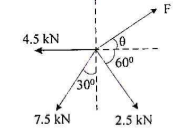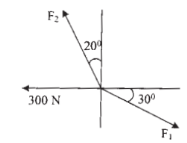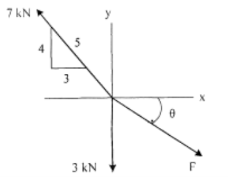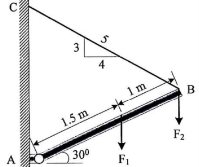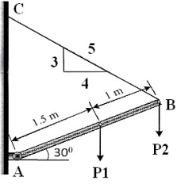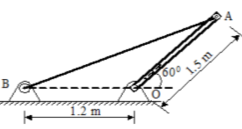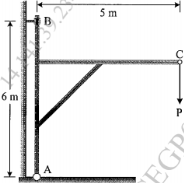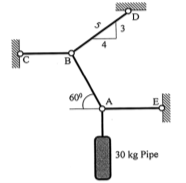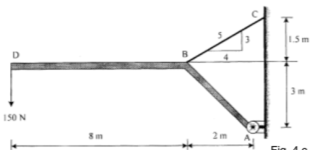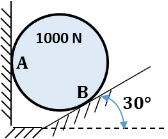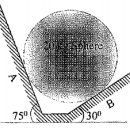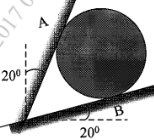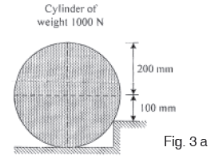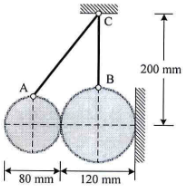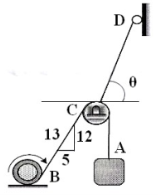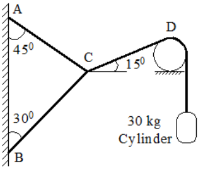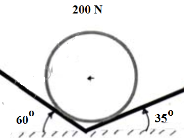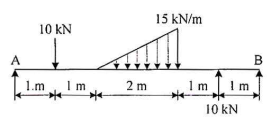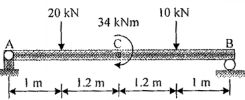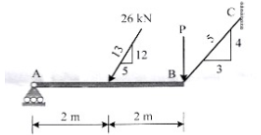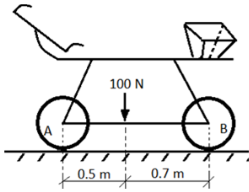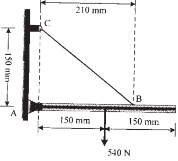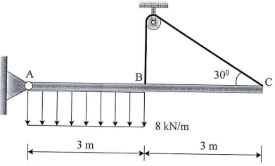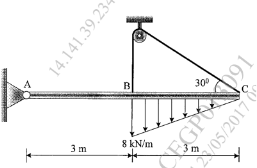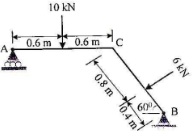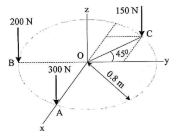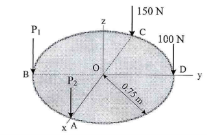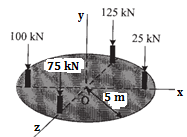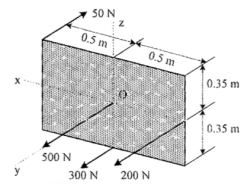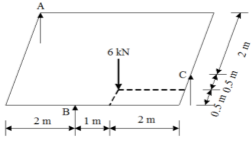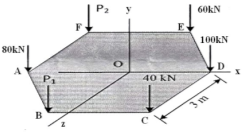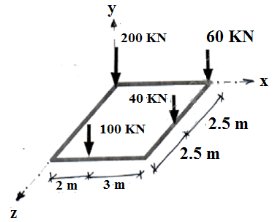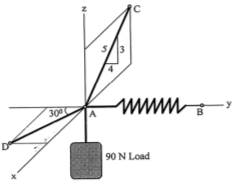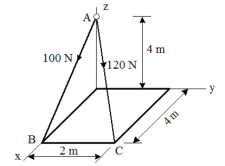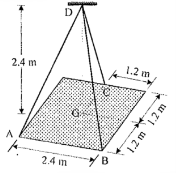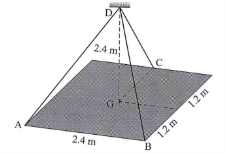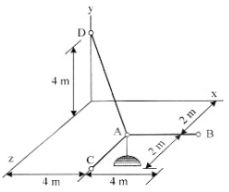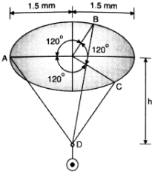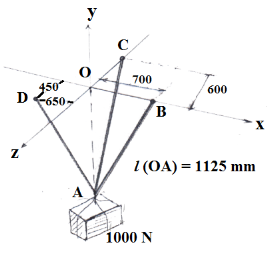Que. No | Question Statement | Que. No | Question Statement | ||
EQUILIBRIUM & LAMI’S THEOREM | |||||
1 |
Co-planer Concurrent Force System Co-planer Non-Concurrent Force System Concurrent Space Force System Parallel Space Force System | ||||
2 | State and explain Two Force and Three Force Principle for equilibrium with sketches. | ||||
3 | Determine the magnitude and position of force F so that the force system shown in Fig. maintain equilibrium.
| 4 | Determine the magnitude of F1 and F2 so that the particle is in equilibrium. Refer Fig.
| ||
5 | Determine the magnitude and direction θ of force F so that the particle is in equilibrium. Refer Fig.
| 6 |
| ||
7 |
| 8 | The uniform 18 kg bar OA is held in position as shown in Fig. by the smooth pin at O and the cable AB. Determine the tension in the cable and the reaction at O.
| ||
9 |
| 10 | The 30 kg pipe is supported at A by a system of five cords as shown in Fig. Determine the force in each cord for equilibrium.
| ||
11 |
| 12 | A sphere weighing 1000 N is placed in a wrench as shown in Fig. Find the reactions at the point of Contacts.
| ||
13 |
| 14 |
| ||
15 | A cylinder of weight 1000 N is rest on the stair as shown in Fig. Determine the minimum magnitude of force P to raise the cylinder over the step.
| 16 |
| ||
17 |
| 18 | Find the angle of tilt θ with the horizontal so that the contact force at B will be one-half that at A for the smooth cylinder. Refer Fig.
| ||
19 |
| 20 | Determine the reactions at all the point of contacts for a sphere of 200 N kept in a trough as shown in the Fig.
| ||
BEAM & SUPPORT REACTIONS | |||||
1 | Determine reaction at A and B for the beam loaded and supported as shown in Fig.
| 2 |
| ||
3 | Determine reaction at for the beam loaded and supported as shown in Fig.
| 4 |
| ||
5 | A simply supported beam AB of span 6 m is loaded and supported as shown in Fig. Find the reactions at support A and B.
| 6 | Determine the support reaction of the beam loaded and supported as shown in Fig. | ||
7 | A beam supports a load varying uniformly from an intensity of w1 kN/m at left end to w2 kN/m at the right end as shown in Fig. If the reactions RL = 6 kN and RR = 12 kN, determine the intensity of loading w1 and w2.
| 8 | The rope BC will fail when the tension becomes 50 kN as shown In Fig. Determine the greatest load P that can be applied to the beam At B and reaction at A for equilibrium.
| ||
9 | Determine the reactions developed at the support if 100 N force is applied on the bicycle as shown in figure.
| 10 |
| ||
11 | Determine the support reaction for the beam loaded and supported as shown in Fig. 50 kN force is inclined at 300 to horizontal.
| 12 | Determine the length a of overhang so that the reaction at B is twice of the reaction at A for the beam loaded and supported as shown in Fig.
| ||
13 | Detrrnine the component. of reaction at hinge A and tension in the cable BC as shown in Fig.
| 14 | Detrrnine the component. of reaction at hinge A and tension in the cable BC as shown in Fig.
| ||
15 | Detrmine the reactions at roller A and pin B for equilibrium of the member ACB as shown in Fig.
| 16 | The beam AB with pin at ‘A’ and roller at ‘B’ loaded as shown in the Fig. Determine the reactions at the supports A &B.
| ||
SPACE FORCES (PARALLEL) | |||||
1 | Three parallel bolting forces act on the rim of the circular cover plate as shown in Fig. Determine the magnitude, nature and point of application of the resultant force with respect to origin O.
| 2 | Four parallel bolting forces act on the rim of the circular cover plate as shown in Fig. If the resultant force 750 N is passing through (0.15 m, 0.1 m) from the origin O, determine the magnitude of forces P1 and P2.
| ||
3 | A concrete foundation mat of 5 m radius supports four equally spaced columns, each of which is located 4 m from the centre of the mat. Determine the magnitude and point of application of the resultant of the four loads as shown in Fig.
| 4 | Determine the resultant of the parallel force system which acts on the plate as shown in Fig.
| ||
5 | Determine the magnitude and direction of a resultant force of a given force system as shown in Fig. and locate its point of application on the slab.
| 6 | A 10 kN platform is supported vertically at A, B and C as shown in Fig. If it carries a load of 6 kN, Determine the reaction at each support.
| ||
7 | A concrete foundation mat in the shape of regular hexagon with 3 m side support column loads as shown in Fig. Determine the magnitude of the additional loads P1 and P2 that must be applied at B and F if resultant of all six loads is to pass through the centre of the mat.
| 8 | Three parallel bolting forces act on the rim of the circular cover plate as shown in Fig. Determine the magnitude, direction and locate point of application of the resultant force on the cover plate.
| ||
9 | The square mat foundations supports four columns as shown in the Fig. Determine the magnitude and position of the esultant force w.r.t. origin ‘O’.
| 10 | Determine the Tension developed in the wires TA, TB, TC Used to Support plate of 1000 N weight as shown in figure.
| ||
SPACE FORCES (CONCURRENT) | |||||
1 |
| 2 | The cable exert forces FAB = 100 N and FAc = 120 N on the ring at A as shown in Fig. Determine the magnitude of the resultant force acting at A.
| ||
3 |
| 4 |
| ||
5 | A rectangular plate is supported by three cables at A as shown in Fig. Knowing that the tension in cable AD is 120 N, determine the weight of the plate.
| 6 | The three cables are used to support the 800 N lamp as shown in Fig. Determine the force developed in each cable for equilibrium.
| ||
7 | The ball is suspended from the horizontal ring using three spring each having a stiffness of k = 50 N/m and an unstretched length of 1.5 m. If h = 2 m, determine the weight of ball. Refer Fig.
| 8 | If each cable can sustain a maximum tension of 600 N, determine the greatest weight of the bucket and its contents that can be supported. Refer Fig.
| ||
9 | Three cables are used to support a container as shown in the Fig. Determine the tension in the cables AB, AC and AD if the weight of the
| 10 | Three Cables are used to support electric pole as shown in figure. Determine Force Developed in each Cable. Assume Self weight of Pole to be 750 N.
| ||
